Led Zeppelin, the titans of rock, crafted a sound that reverberates through generations. From Jimmy Page’s groundbreaking riffs to Robert Plant’s soaring vocals, John Paul Jones’s versatile musicianship, and John Bonham’s earth-shattering drums, their music is a blueprint for rock and roll greatness. Defining the “best” Led Zeppelin songs is a thrilling, albeit subjective, journey. This guide explores a selection of their most iconic tracks, delving into the magic behind the music and why these songs continue to captivate listeners worldwide.
‘Whole Lotta Love’ (1969)
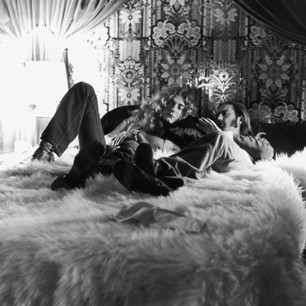 Robert Plant Led Zeppelin singing passionately into microphone
Robert Plant Led Zeppelin singing passionately into microphone
Image Credit: Photo by Express Newspapers/Getty Images
“Whole Lotta Love” isn’t just a song; it’s a statement. This track from Led Zeppelin II is raw, audacious, and utterly iconic. Robert Plant’s suggestive lyrics and vocal delivery push boundaries, while Jimmy Page’s riff, amplified by backward echo and a metal slide, is a cornerstone of hard rock. The song’s psychedelic midsection, a swirling vortex of sound effects and Plant’s ecstatic moans, was a studio innovation born from happy accident, showcasing Led Zeppelin’s pioneering spirit. Despite lyrical nods to Willie Dixon’s “You Need Love,” “Whole Lotta Love” became a beast of its own, defining Led Zeppelin’s blues-infused, hard-rocking persona.
‘Stairway to Heaven’ (1971)
 Jimmy Page Led Zeppelin playing guitar during Stairway to Heaven performance at Madison Square Garden
Jimmy Page Led Zeppelin playing guitar during Stairway to Heaven performance at Madison Square Garden
Image Credit: Photo by Richard E. Aaron/Getty Images
“Stairway to Heaven,” from Led Zeppelin IV, is more than a song; it’s a rock epic. Spanning eight minutes, it unfolds with a delicate, almost medieval acoustic introduction before building into a powerful rock crescendo. Plant’s mystical lyrics and Page’s legendary, improvised guitar solo contribute to its enduring mystique. The song’s dynamic progression, likened by Page to an “adrenaline flow,” and its blend of folk, rock, and mystical elements cemented its status as a rock monolith and a cornerstone of 1970s rock. Its slow-burn intensity and masterful composition continue to inspire awe.
‘Black Dog’ (1971)
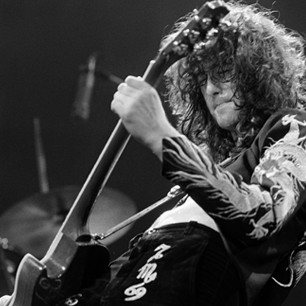 Jimmy Page Led Zeppelin performing live in a black and white photo
Jimmy Page Led Zeppelin performing live in a black and white photo
Image Credit: Photo by Terry O’Neill/Getty Images
“Black Dog,” another gem from Led Zeppelin IV, kicks off with one of the most instantly recognizable riffs in rock history, conceived by John Paul Jones. Jimmy Page transforms this idea into a guitar masterclass, layered with multitracked rhythm guitars and propelled by John Bonham’s powerful drumming. Robert Plant’s suggestive vocals add to the song’s raw energy and bluesy undertones. While not lyrically complex, “Black Dog” is a masterclass in musical chemistry, showcasing the band’s tight interplay and sheer rock power.
‘Kashmir’ (1975)
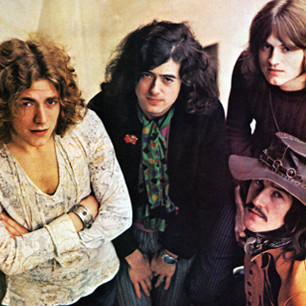 Led Zeppelin group shot with Jimmy Page, Robert Plant, John Bonham, and John Paul Jones in suits
Led Zeppelin group shot with Jimmy Page, Robert Plant, John Bonham, and John Paul Jones in suits
Image Credit: Photo by Getty Images
“Kashmir,” from Physical Graffiti, is Led Zeppelin at their most majestic and expansive. Its grandeur stems from a combination of John Paul Jones’s Mellotron orchestrations, augmented by real strings and brass, John Bonham’s thunderous drumming, and Jimmy Page’s guitar work, infused with Middle Eastern and Indian influences. Inspired by a drive through Morocco, Robert Plant’s lyrics evoke a sense of epic journey and timelessness. Often considered their most sonically immense track, “Kashmir” is a testament to Led Zeppelin’s ambition and musical scope.
‘Ramble On’ (1969)
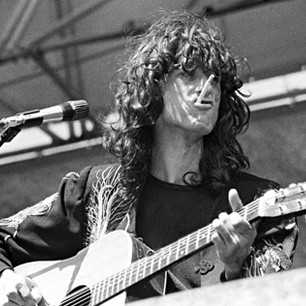 Jimmy Page Led Zeppelin playing acoustic guitar in a close-up shot
Jimmy Page Led Zeppelin playing acoustic guitar in a close-up shot
Image Credit: Photo by Ed Perlstein/Getty Images
“Ramble On,” from Led Zeppelin II, blends folk-blues sensibilities with lyrical fantasy. Robert Plant’s lyrics, referencing The Lord of the Rings, mark the emergence of his mystical persona. The song begins with Jimmy Page’s delicate acoustic guitar and John Bonham’s percussive rhythms, possibly created on his knees or a guitar case, before erupting into a powerful chorus with Page’s electric guitar. “Ramble On” showcases Led Zeppelin’s dynamic range and their ability to fuse seemingly disparate genres into a cohesive and compelling sound.
‘Good Times Bad Times’ (1969)
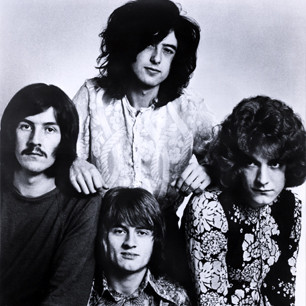 Led Zeppelin band members in a black and white photo, Jimmy Page, Robert Plant, John Bonham, and John Paul Jones looking cool
Led Zeppelin band members in a black and white photo, Jimmy Page, Robert Plant, John Bonham, and John Paul Jones looking cool
Image Credit: Photo by Getty Images
“Good Times Bad Times,” the opening track of Led Zeppelin’s debut album, is a powerful introduction to the band’s explosive energy. Jimmy Page’s “stun-gun riff” and John Bonham’s complex, syncopated drumming immediately establish their musical prowess. While the lyrics are rooted in classic blues themes of troubled relationships, the song’s impact is immediate and visceral. “Good Times Bad Times” announced Led Zeppelin’s arrival as a force to be reckoned with, pushing the boundaries of four-piece rock dynamics.
‘Immigrant Song’ (1970)
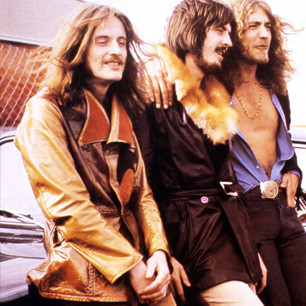 Led Zeppelin performing live, Jimmy Page, Robert Plant, John Bonham, and John Paul Jones in action
Led Zeppelin performing live, Jimmy Page, Robert Plant, John Bonham, and John Paul Jones in action
Image Credit: Photo by Getty Images
“Immigrant Song,” from Led Zeppelin III, bursts forth with an unforgettable opening line: “We come from the land of the ice and snow.” Inspired by a concert in Iceland, Robert Plant’s Viking-themed lyrics and primal “Tarzan holler” vocals are matched by Jimmy Page’s menacing, staccato riff. The song is both powerful and tongue-in-cheek, showcasing Led Zeppelin’s ability to blend mythology with hard rock intensity. “Immigrant Song” remains a high-energy classic, instantly recognizable and undeniably powerful.
‘When the Levee Breaks’ (1971)
 Robert Plant Led Zeppelin playing harmonica during a performance
Robert Plant Led Zeppelin playing harmonica during a performance
Image Credit: Photo by Jorgen Angel/Getty Images
“When the Levee Breaks,” from Led Zeppelin IV, is a blues masterpiece transformed into a sonic landscape of epic proportions. Drawing from Memphis Minnie’s blues lament about a flood, Led Zeppelin, spearheaded by Jimmy Page’s production, created a haunting and atmospheric track using heavy echo, reversed harmonica, and slowed-down playback. John Bonham’s drums, famously recorded in a stairwell for their immense sound, became a sampling landmark. “When the Levee Breaks” is Led Zeppelin at their most experimental and sonically groundbreaking.
‘Rock and Roll’ (1971)
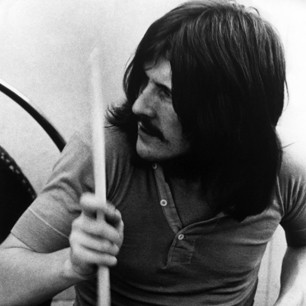 John Bonham Led Zeppelin playing drums with intensity
John Bonham Led Zeppelin playing drums with intensity
Image Credit: Photo by Charlie Gillett/Getty Images
“Rock and Roll,” from Led Zeppelin IV, is pure, unadulterated rock and roll energy. Born spontaneously during a rehearsal, John Bonham’s iconic drum intro, inspired by Little Richard, ignites a track that celebrates the spirit of 1950s rock and roll while forging a modern, fiercer sound. Robert Plant’s lyrics evoke youthful exuberance and classic rock and roll dances, while the music is anything but nostalgic. “Rock and Roll” is a timeless anthem, capturing the raw energy and excitement of the genre.
‘Misty Mountain Hop’ (1971)
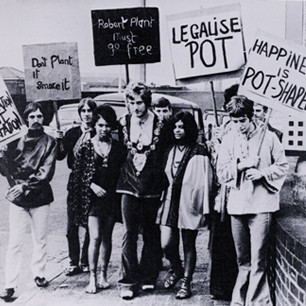 Robert Plant Led Zeppelin in a casual pose
Robert Plant Led Zeppelin in a casual pose
Image Credit: Photo by Getty Images
“Misty Mountain Hop,” from Led Zeppelin IV, is a surprisingly funky track with lyrical nods to Tolkien and counter-culture. John Paul Jones’s electric piano groove, combined with Jimmy Page’s driving riff and John Bonham’s dynamic drumming, creates a uniquely infectious rhythm. Robert Plant’s lyrics, initially inspired by a park incident involving “wrong stuff in your cigarette papers,” blend fantasy and real-world rebellion. “Misty Mountain Hop” showcases Led Zeppelin’s versatility, proving they could be both heavy and surprisingly groovy.
‘Going to California’ (1971)
 John Paul Jones Led Zeppelin playing mandolin and three-neck guitar on stage
John Paul Jones Led Zeppelin playing mandolin and three-neck guitar on stage
Image Credit: Photo by Terry O’Neill/Getty Images
“Going to California,” from Led Zeppelin IV, is a moment of gentle beauty within Led Zeppelin’s catalog. Jimmy Page’s delicate acoustic fingerpicking and John Paul Jones’s mandolin create a warm, folk-inspired soundscape. Robert Plant’s vocals take on a softer, almost country-tinged quality, with lyrics rumored to be about Joni Mitchell or perhaps a composite of the many Californian women who crossed the band’s path. “Going to California” demonstrates Led Zeppelin’s softer side, proving their mastery extended beyond hard rock anthems.
‘Communication Breakdown’ (1969)
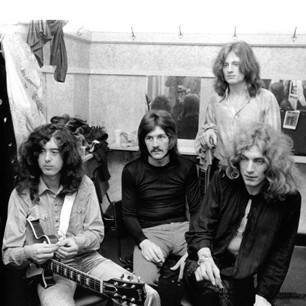 Led Zeppelin backstage in black and white, Jimmy Page, Robert Plant, John Bonham, and John Paul Jones relaxed
Led Zeppelin backstage in black and white, Jimmy Page, Robert Plant, John Bonham, and John Paul Jones relaxed
Image Credit: Photo by Chris Walter/Getty Images
“Communication Breakdown,” from Led Zeppelin, is a raw, high-energy track that foreshadows punk rock. Jimmy Page’s down-stroke riff is relentlessly driving, while the song’s overall attack is brutally direct. Lyrically alluding to Eddie Cochran’s “Nervous Breakdown,” “Communication Breakdown” takes 1950s rock and roll energy and amplifies it with a ferocious intensity that was groundbreaking in 1969. It stands as a testament to Led Zeppelin’s ability to innovate and push musical boundaries from their very beginning.
‘Dazed and Confused’ (1969)
 Jimmy Page Led Zeppelin playing guitar with a bow in a dramatic pose
Jimmy Page Led Zeppelin playing guitar with a bow in a dramatic pose
Image Credit: Photo by Terry O’Neill/Getty Images
“Dazed and Confused,” from Led Zeppelin, became a cornerstone of Led Zeppelin’s live performances, evolving into extended improvisational jams. Originally written by singer-songwriter Jake Holmes, Jimmy Page reimagined it for Led Zeppelin, creating a psychedelic blues epic. Page’s signature bowed guitar solos became a central feature of the live versions, often stretching the song to incredible lengths. “Dazed and Confused” is a showcase for Led Zeppelin’s improvisational prowess and their ability to transform a song into a vehicle for sonic exploration.
‘The Ocean’ (1973)
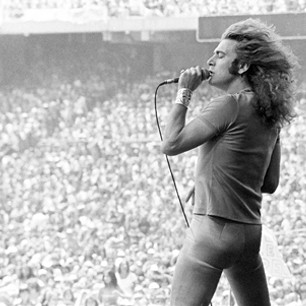 Robert Plant Led Zeppelin performing live with microphone stand
Robert Plant Led Zeppelin performing live with microphone stand
Image Credit: Photo by Ed Perlstein/Getty Images
“The Ocean,” from Houses of the Holy, is a tribute to Led Zeppelin’s devoted fanbase. Its complex, funky rhythm, driven by John Bonham’s drumming, has challenged air drummers for decades. The song also features rare backing vocals from Bonham and Jones in the outro, and Bonham’s count-in is iconic in itself, sounding like a blend of pirate and rapper. “The Ocean” is a high-energy, rhythmically intricate track that celebrates the band-fan connection and their unique musical blend.
‘What Is and What Should Never Be’ (1969)
 Robert Plant Led Zeppelin in a thoughtful pose
Robert Plant Led Zeppelin in a thoughtful pose
Image Credit: Photo by Chris Walter/Getty Images
“What Is and What Should Never Be,” from Led Zeppelin II, is a song of contrasting dynamics and shifting moods. Rumored to be about Robert Plant’s affair with his wife’s sister, the lyrics explore forbidden desire. Musically, the song moves from tender, pastoral verses to powerful, heavy choruses, showcasing Led Zeppelin’s mastery of dynamics and their ability to create music that is both sensual and forceful. “What Is and What Should Never Be” is a compelling example of Led Zeppelin’s nuanced songwriting and emotional depth.
‘Over the Hills and Far Away’ (1973)
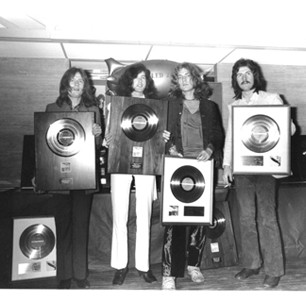 Led Zeppelin performing live, Jimmy Page, Robert Plant, John Bonham, and John Paul Jones in action
Led Zeppelin performing live, Jimmy Page, Robert Plant, John Bonham, and John Paul Jones in action
Image Credit: Photo by Chris Walter/Getty Images
“Over the Hills and Far Away,” from Houses of the Holy, is an uncharacteristically upbeat and almost poppy track for Led Zeppelin. It opens with Jimmy Page’s bright, acoustic guitar strumming before the full band kicks in with a driving, boogie-rock rhythm. Robert Plant’s lyrics are straightforward and romantic, adding to the song’s accessible and energetic feel. Despite being released as a single, it surprisingly didn’t reach the Top 50, but “Over the Hills and Far Away” remains a fan favorite for its infectious melody and positive energy.
‘The Battle of Evermore’ (1971)
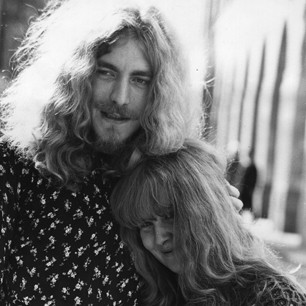 Robert Plant and Sandy Denny singing together on stage
Robert Plant and Sandy Denny singing together on stage
Image Credit: Photo by Michael Stroud/Getty Images
“The Battle of Evermore,” from Led Zeppelin IV, showcases Led Zeppelin’s deep appreciation for folk music. Featuring Sandy Denny of Fairport Convention on vocals, alongside Robert Plant, and Jimmy Page on mandolin, the song is a unique collaboration. Lyrically inspired by The Lord of the Rings, it evokes a mystical, medieval atmosphere. “The Battle of Evermore” is a testament to Led Zeppelin’s eclecticism and their willingness to explore musical territories beyond hard rock.
‘The Song Remains the Same’ (1973)
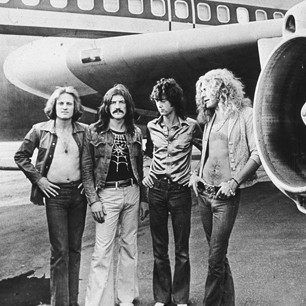 Led Zeppelin band members in a line, Jimmy Page, Robert Plant, John Bonham, and John Paul Jones in suits
Led Zeppelin band members in a line, Jimmy Page, Robert Plant, John Bonham, and John Paul Jones in suits
Image Credit: Photo by Getty Images
“The Song Remains the Same,” from Houses of the Holy, is an uplifting and celebratory track, originally conceived as an instrumental. Inspired by Jimmy Page and Robert Plant’s trip to Bombay, the song has a raga-influenced feel. It’s a testament to music’s universal power and Led Zeppelin’s global reach as they became one of the biggest bands in the world. “The Song Remains the Same” is a vibrant and optimistic track, showcasing Led Zeppelin’s musical confidence and global perspective.
‘Gallows Pole’ (1970)
 Robert Plant and John Paul Jones Led Zeppelin playing mandolin during a performance
Robert Plant and John Paul Jones Led Zeppelin playing mandolin during a performance
Image Credit: Photo by Larry Hulst/Getty Images
“Gallows Pole,” from Led Zeppelin III, is the oldest song in Led Zeppelin’s repertoire, originating from the centuries-old folk ballad “The Maid Freed From the Gallows.” Led Zeppelin’s arrangement builds dramatically, incorporating banjo played by Jimmy Page and mandolin by John Paul Jones, creating a frantic, escalating tension that culminates in a dramatic ending. “Gallows Pole” demonstrates Led Zeppelin’s ability to reinterpret traditional folk material and infuse it with their signature energy and theatricality.
‘D’yer Mak’er’ (1973)
 Jimmy Page and Robert Plant Led Zeppelin performing live together on stage
Jimmy Page and Robert Plant Led Zeppelin performing live together on stage
Image Credit: Photo by Christ Walter/Getty Images
“D’yer Mak’er,” from Houses of the Holy, is Led Zeppelin’s playful foray into reggae, a then-emerging genre in 1972. Starting with the idea of playing reggae, the band crafted a unique blend of rock-steady rhythms, heavy metal elements, and even doo-wop influences. Robert Plant’s lighthearted vocals and catchy melodies result in one of Led Zeppelin’s most accessible and pop-oriented songs. “D’yer Mak’er” is a testament to Led Zeppelin’s musical curiosity and their ability to experiment with diverse genres.
‘Dancing Days’ (1973)
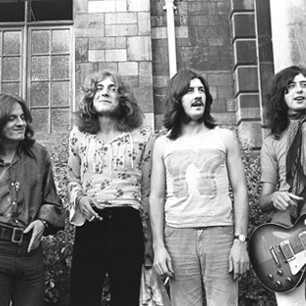 Led Zeppelin group shot in color, Jimmy Page, Robert Plant, John Bonham, and John Paul Jones smiling
Led Zeppelin group shot in color, Jimmy Page, Robert Plant, John Bonham, and John Paul Jones smiling
Image Credit: Photo by Chris Walter/Getty Images
“Dancing Days,” from Houses of the Holy, is a vibrant and upbeat track inspired by Jimmy Page and Robert Plant’s trip to Bombay. Recorded at Mick Jagger’s country home, the band was so enthused by the song that they danced to it on the lawn. The music, particularly the searing slide guitar riff, captures the energy of their travels, while the lyrics evoke a summery, carefree atmosphere, almost reminiscent of the Beach Boys. “Dancing Days” is a joyful and energetic track, showcasing Led Zeppelin’s ability to infuse their music with global influences and positive vibes.
‘Heartbreaker’ (1969)
 Jimmy Page Led Zeppelin playing guitar intensely during a live performance
Jimmy Page Led Zeppelin playing guitar intensely during a live performance
Image Credit: Photo by Michael Ochs/Getty Images
“Heartbreaker,” from Led Zeppelin II, is a showcase for Jimmy Page’s guitar virtuosity, featuring a groundbreaking solo that became a heavy metal blueprint. Legend has it that Eddie Van Halen was inspired by Page’s pyrotechnics. The song itself is a hard-rocking anthem about a deceitful woman, becoming a live staple where Page would often incorporate classical music quotes into his improvisations. “Heartbreaker” is a seminal track in the development of heavy metal guitar playing and a testament to Page’s innovative style.
‘Nobody’s Fault But Mine’ (1976)
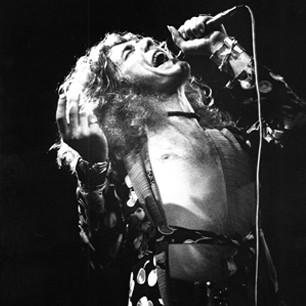 Robert Plant Led Zeppelin performing live with dramatic lighting
Robert Plant Led Zeppelin performing live with dramatic lighting
Image Credit: Photo by Gijsbert Hanekroot/Getty Images
“Nobody’s Fault But Mine,” from Presence, is a dark and intense blues lament, amplifying the starkness of Blind Willie Johnson’s original gospel blues song. Robert Plant’s vocals are raw and emotive, while Jimmy Page’s opening riff is described as epic and otherworldly. The song’s atmosphere is heavy and foreboding, creating a sense of cosmic blues. “Nobody’s Fault But Mine” is a powerful example of Led Zeppelin’s ability to transform blues tradition into something both contemporary and timeless.
‘Fool in the Rain’ (1979)
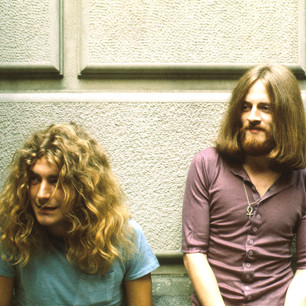 Robert Plant and John Paul Jones Led Zeppelin performing together on stage
Robert Plant and John Paul Jones Led Zeppelin performing together on stage
Image Credit: Photo by Jeffrey Mayer/Getty Images
“Fool in the Rain,” from In Through the Out Door, demonstrates Led Zeppelin’s restless musical exploration. Inspired by a samba rhythm John Paul Jones and Robert Plant heard during the 1978 World Cup, the song incorporates a Latin-infused middle section. Despite the punk rock movement’s dismissal of bands like Led Zeppelin at the time, “Fool in the Rain” showcases their continued creativity and willingness to experiment with new sounds. “Fool in the Rain” is a testament to Led Zeppelin’s enduring musical evolution.
‘Babe I’m Gonna Leave You’ (1969)
 Jimmy Page Led Zeppelin in a portrait shot with guitar
Jimmy Page Led Zeppelin in a portrait shot with guitar
Image Credit: Photo by Chris Walter/Getty Images
“Babe I’m Gonna Leave You,” from Led Zeppelin, is a powerful cover song that Led Zeppelin transformed into their own. Originally a Joan Baez folk song, Led Zeppelin’s version builds from delicate acoustic sections to explosive heavy rock passages. Their interpretation showcases their ability to take a folk song and imbue it with their signature power and dynamics, drawing from American folk music in a way that was unique for bands of the era. “Babe I’m Gonna Leave You” is a powerful example of Led Zeppelin’s interpretive skills and their ability to make a song their own.
‘Trampled Under Foot’ (1975)
 Led Zeppelin group shot in color, Jimmy Page, Robert Plant, John Bonham, and John Paul Jones in action
Led Zeppelin group shot in color, Jimmy Page, Robert Plant, John Bonham, and John Paul Jones in action
Image Credit: Photo by Dick Barnatt/Getty Images
“Trampled Under Foot,” from Physical Graffiti, is arguably Led Zeppelin’s funkiest track. Inspired by Stevie Wonder’s “Superstition,” John Paul Jones plays clavinet, and Jimmy Page utilizes a wah-wah pedal, creating a groove driven by John Bonham’s proto-disco beat. Robert Plant’s lyrics employ sexual metaphors using car imagery, echoing Robert Johnson’s “Terraplane Blues.” “Trampled Under Foot” is a surprisingly danceable and groove-oriented track, showcasing Led Zeppelin’s versatility and willingness to experiment with funk rhythms.
‘Houses of the Holy’ (1975)
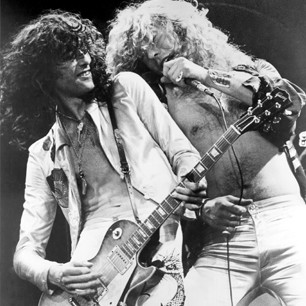 Jimmy Page and Robert Plant Led Zeppelin performing live together on stage
Jimmy Page and Robert Plant Led Zeppelin performing live together on stage
Image Credit: Photo by Michael Ochs/Getty Images
“Houses of the Holy,” from Physical Graffiti, despite being recorded for the album of the same name, was initially shelved for sounding too similar to “Dancing Days.” Resurrected for Physical Graffiti, it’s a stomping, energetic track with Jimmy Page’s signature guitar work and Robert Plant’s evocative lyrics referencing fertility rites and tarot readings. Rick Rubin described it as “one of their most compact-feeling songs,” highlighting its focused energy. “Houses of the Holy” is a powerful and concise rocker that embodies Led Zeppelin’s raw energy.
‘No Quarter’ (1973)
 John Paul Jones Led Zeppelin playing organ and piano in a focused shot
John Paul Jones Led Zeppelin playing organ and piano in a focused shot
Image Credit: Photo by Getty Images
“No Quarter,” from Houses of the Holy, is Led Zeppelin’s most psychedelic and atmospheric track since “Dazed and Confused.” It’s a showcase for John Paul Jones’s musicianship, featuring a cool-jazz piano interlude in the middle section alongside Jimmy Page’s fluid guitar lines. The lyrics, with lines like “Walking side by side with death,” contribute to the song’s mystique and helped lay the groundwork for heavy metal mythology. “No Quarter” is a journey into Led Zeppelin’s more experimental and atmospheric side.
‘Thank You’ (1969)
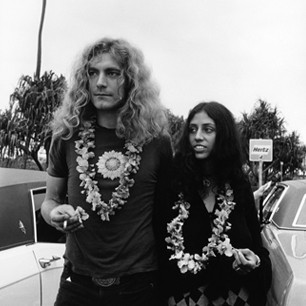 Robert Plant and Maureen Wilson, his wife, in Honolulu, Hawaii, in a candid shot
Robert Plant and Maureen Wilson, his wife, in Honolulu, Hawaii, in a candid shot
Image Credit: Photo by Robert Knight/Getty Images
“Thank You,” from Led Zeppelin II, offers a rare glimpse into Led Zeppelin’s tender and romantic side. Robert Plant’s lyrics are a heartfelt dedication to his wife, Maureen Wilson, while John Paul Jones’s regal organ part adds to the song’s majestic feel. Plant himself noted the band’s duality, saying “Sometimes Zeppelin was gross and very indecent, and sometimes it was delicate and beautiful.” “Thank You” is a beautiful ballad that reveals Led Zeppelin’s capacity for tenderness and genuine emotion.
‘In My Time of Dying’ (1975)
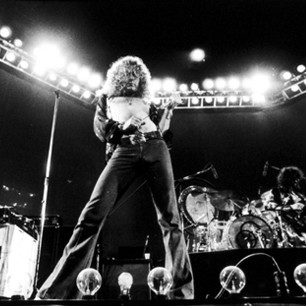 Robert Plant Led Zeppelin performing live with dramatic pose
Robert Plant Led Zeppelin performing live with dramatic pose
Image Credit: Photo by Michael Putland/Getty Images
“In My Time of Dying,” from Physical Graffiti, is Led Zeppelin’s longest studio recording, transforming a gospel standard into a stadium-sized epic. Jimmy Page’s grinding slide guitar, John Paul Jones’s shape-shifting bassline, and John Bonham’s massive groove create a powerful foundation for Robert Plant’s vocals. Live performances often included Plant dedicating the song to Queen Elizabeth in a playful nod to the band’s tax exile status. “In My Time of Dying” is a monumental track that demonstrates Led Zeppelin’s ability to amplify and transform traditional blues and gospel into something uniquely their own.
‘Moby Dick’ (1969)
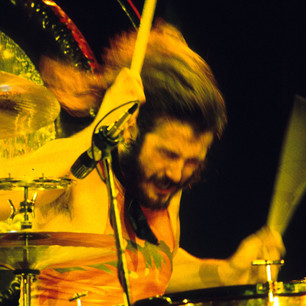 John Bonham Led Zeppelin performing an extended drum solo on stage
John Bonham Led Zeppelin performing an extended drum solo on stage
Image Credit: Photo by Jeffrey Mayer/Getty Images
“Moby Dick,” from Led Zeppelin II, is a showcase for John Bonham’s legendary drumming. Evolving from a jam based on Sleepy John Estes’ “The Girl I Love She Got Long Black Wavy Hair,” it became Bonham’s drum solo showcase. Live versions could stretch to 30 minutes, while the studio version is a concise four-minute display of syncopated rhythms and thunderous tom-tom work. “Moby Dick” is a drum solo masterclass and a testament to John Bonham’s unparalleled talent and power.
‘The Wanton Song’ (1975)
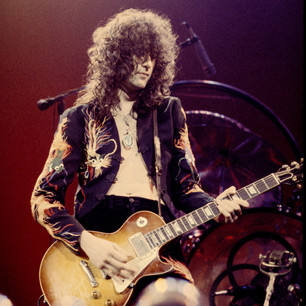 Jimmy Page Led Zeppelin playing guitar solo during a live performance
Jimmy Page Led Zeppelin playing guitar solo during a live performance
Image Credit: Photo by Chris Walter/Getty Images
“The Wanton Song,” from Physical Graffiti, features a riff that Dave Grohl considers one of the greatest of all time. Its galloping rhythm, reminiscent of “Immigrant Song,” is made fresh by Jimmy Page’s innovative 3D guitar solo. Robert Plant’s suggestive lyrics add to the song’s raw and powerful energy. “The Wanton Song” is a prime example of Led Zeppelin’s riff-driven rock and their ability to create instantly memorable and impactful music.
‘Living Loving Maid (She’s Just a Woman)’ (1969)
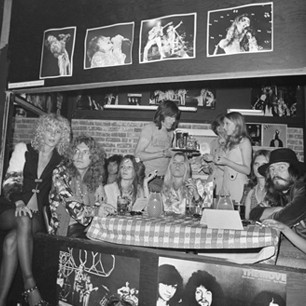 Led Zeppelin group shot with Jimmy Page, Robert Plant, John Bonham, and John Paul Jones surrounded by groupies
Led Zeppelin group shot with Jimmy Page, Robert Plant, John Bonham, and John Paul Jones surrounded by groupies
Image Credit: Photo by Michael Ochs/Getty Images
“Living Loving Maid (She’s Just a Woman),” from Led Zeppelin II, is a fast-paced rocker about a groupie. Despite Jimmy Page’s reported dislike for the song and its absence from their 1990 box set and live performances, it became a radio hit. Its hard-twanging guitars and energetic rhythm make it a classic example of Led Zeppelin’s early, raw sound. “Living Loving Maid” is a high-energy track that captures the band’s early hard rock intensity.
‘The Rain Song’ (1973)
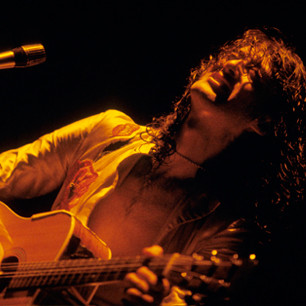 Jimmy Page Led Zeppelin playing guitar solo during a live performance in soft lighting
Jimmy Page Led Zeppelin playing guitar solo during a live performance in soft lighting
Image Credit: Photo by Richard E. Aaron/Getty Images
“The Rain Song,” from Houses of the Holy, is a showcase for Jimmy Page’s exquisite guitar work and Led Zeppelin’s more ballad-oriented side. Legend has it that it was written in response to George Harrison’s teasing comment that Led Zeppelin didn’t play ballads. Page’s layers of acoustic and electric guitars, alongside John Paul Jones’s Mellotron, create a lush and beautiful soundscape, while Robert Plant and John Bonham still bring in moments of powerful rock intensity. “The Rain Song” is a gorgeous ballad that demonstrates Led Zeppelin’s dynamic range and their ability to create both delicate and powerful music.
‘Tangerine’ (1970)
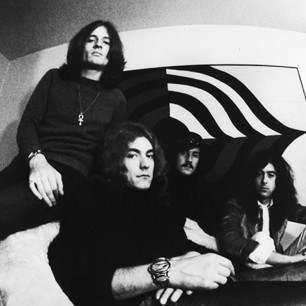 Led Zeppelin group shot in black and white, Jimmy Page, Robert Plant, John Bonham, and John Paul Jones in suits
Led Zeppelin group shot in black and white, Jimmy Page, Robert Plant, John Bonham, and John Paul Jones in suits
Image Credit: Photo by Gilles Petard/Getty Images
“Tangerine,” from Led Zeppelin III, is Led Zeppelin’s foray into country-tinged music. Originally written by Jimmy Page and Keith Relf for The Yardbirds, Page resurrected it with new lyrics by Robert Plant, described as being about “love in its most innocent stages.” Its gentle melody and heartfelt lyrics showcase a different side of Led Zeppelin, proving their musical versatility and emotional depth. “Tangerine” is a beautiful and tender track that highlights Led Zeppelin’s softer side.
‘Since I’ve Been Loving You’ (1970)
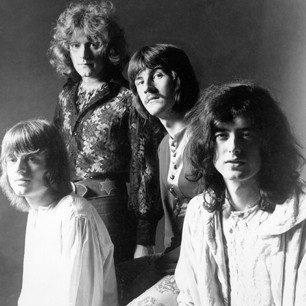 Led Zeppelin group shot in black and white, Jimmy Page, Robert Plant, John Bonham, and John Paul Jones in suits
Led Zeppelin group shot in black and white, Jimmy Page, Robert Plant, John Bonham, and John Paul Jones in suits
Image Credit: Photo by Michael Ochs/Getty Images
“Since I’ve Been Loving You,” from Led Zeppelin III, is a slow blues epic that showcases Led Zeppelin’s soulful side. Jimmy Page spent months perfecting his guitar solo, ultimately returning to his original demo version. The result is a powerful and emotionally charged performance, with Page’s guitar ranging from spare to raucous, John Paul Jones’s blazing organ, and Robert Plant’s heart-wrenching vocals. “Since I’ve Been Loving You” is a blues masterpiece that demonstrates Led Zeppelin’s emotional depth and musical virtuosity.
‘Four Sticks’ (1971)
Image Credit: Photo by Richard E. Aaron/Getty Images
“Four Sticks,” from Led Zeppelin IV, is an exotic and rhythmically complex track that nearly didn’t make the album. Built around Jimmy Page’s guitar riffs and shifting time signatures, the song proved difficult to record until John Bonham, after a pub visit, nailed the drumming, famously using two sticks in each hand, hence the title. “Four Sticks” is a testament to Led Zeppelin’s experimental nature and their ability to overcome musical challenges to create something unique.
‘Traveling Riverside Blues’ (1969)
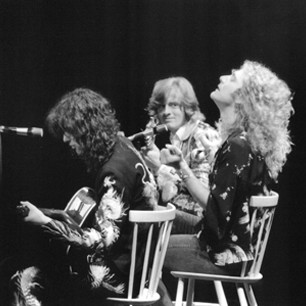 Led Zeppelin acoustic performance, Jimmy Page, Robert Plant, John Bonham, and John Paul Jones in a relaxed setting
Led Zeppelin acoustic performance, Jimmy Page, Robert Plant, John Bonham, and John Paul Jones in a relaxed setting
Image Credit: Photo by Chris Walter/Getty Images
“Traveling Riverside Blues,” recorded during a BBC Radio session, is a loose and improvisational take on a Robert Johnson blues song. Jimmy Page showcases his manic acoustic slide guitar playing, while Robert Plant develops the “squeeze my lemon” lyric that would later become famous in “The Lemon Song.” “Traveling Riverside Blues” offers a glimpse into Led Zeppelin’s early improvisational style and their deep roots in the blues.
‘All My Love’ (1979)
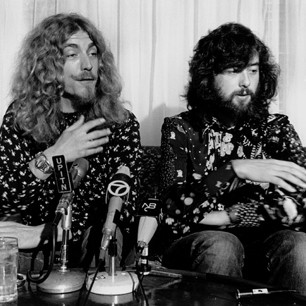 Robert Plant and Jimmy Page Led Zeppelin in a close-up, serious expressions
Robert Plant and Jimmy Page Led Zeppelin in a close-up, serious expressions
Image Credit: Photo by Michael Ochs/Getty Images
“All My Love,” from In Through the Out Door, is a majestic and deeply personal song, one of only two Led Zeppelin tracks not co-written by Jimmy Page. It’s Robert Plant’s tribute to his son Karac, who tragically passed away in 1977. John Paul Jones’s soaring synthesizer solo adds to the song’s emotional weight. While Page reportedly disliked the song, its emotional significance to Plant made it untouchable. “All My Love” is a poignant and beautiful ballad that reveals the personal tragedies that shaped Led Zeppelin’s later work.
‘In the Evening’ (1979)
 Led Zeppelin performing live, Jimmy Page, Robert Plant, John Bonham, and John Paul Jones in action on a dark stage
Led Zeppelin performing live, Jimmy Page, Robert Plant, John Bonham, and John Paul Jones in action on a dark stage
Image Credit: Photo by Richard E. Aaron/Getty Images
“In the Evening,” the opening track of In Through the Out Door, is a sweeping anthem that blends Led Zeppelin’s rock power with John Paul Jones’s interest in electronics. Jimmy Page uses a Gizmotron with his guitar, Jones plays Abba-esque synths, Robert Plant sings about loneliness, and John Bonham delivers a powerful, almost primal drum performance. “In the Evening” is a dynamic and epic track that served as Led Zeppelin’s last grand statement, bridging their classic sound with new sonic textures.
This exploration of the Best Led Zeppelin Songs offers just a glimpse into their immense catalog. Each track reveals a different facet of their musical genius, from raw blues power to delicate acoustic beauty, from hard rock anthems to experimental soundscapes. Led Zeppelin’s music continues to inspire and influence, solidifying their place as true legends of rock and roll.

